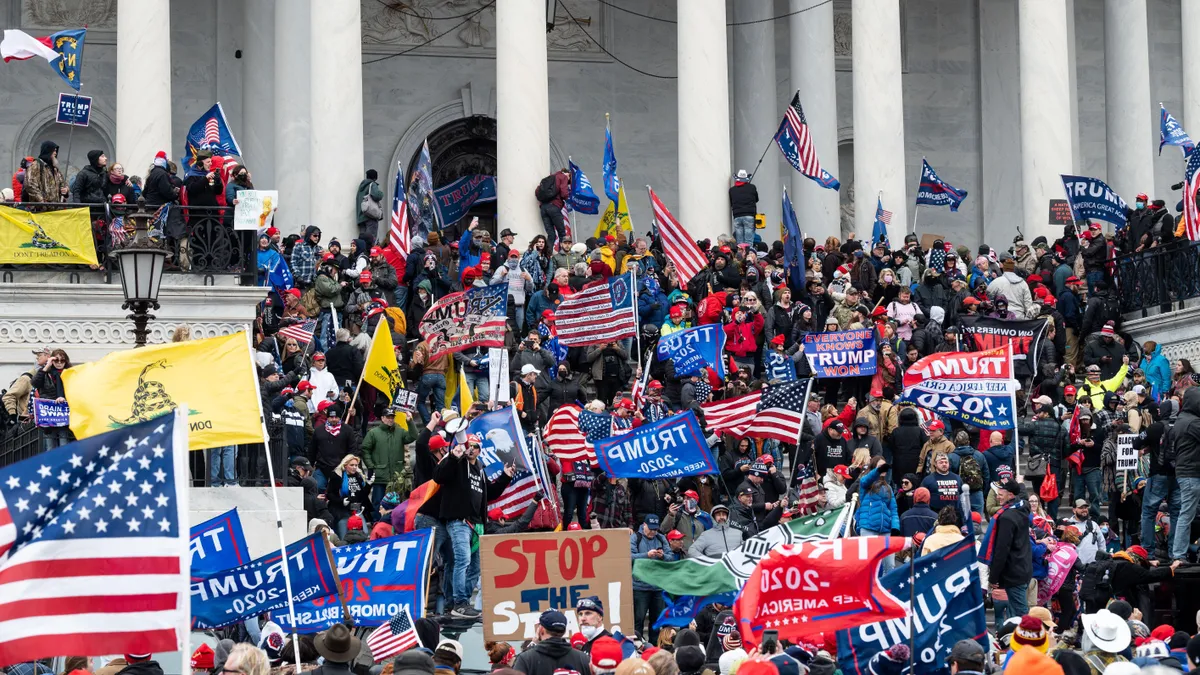Dive Brief:
- The U.S. Capitol in Washington, D.C., was stormed Wednesday afternoon by a mob supporting President Donald Trump, aiming to disrupt the House and Senate certification process of President-elect Joe Biden's win in the 2020 presidential election. The events present educators with yet another difficult topic to navigate in classroom discussion.
- In addition to creating potentially loaded debate in the classroom, the events — which NPR reports left four dead and resulted in dozens of police injuries and arrests — also require educators to be prepared to provide supports for students whose anxiety and uncertainty is spiked by footage and photos of the events in the news and on social media.
- A number of education organizations have resources available that offer blueprints for talking to students about protests, unsettling information and violent events — including Facing History and Ourselves, Common Sense Media, the National Association of School Psychologists and the National Education Association.
Our nation hasn't witnessed an event like today in recent history and it’s difficult to make sense of the scenes, let alone explain them to our children. But what's important to remind them of is that Americans are uniting to support justice and democracy.https://t.co/S97yHWHsZZ
— NEA (@NEAToday) January 7, 2021
Dive Insight:
In the wake of the storming of the Capitol building, education leaders, including current U.S. Secretary of Education Betsy DeVos and her expected successor, Miguel A. Cardona, issued statements via social media condemning the events.
— Secretary Betsy DeVos (@BetsyDeVosED) January 6, 2021
Our kids deserve better. History has its eyes on us.
— Dr. Miguel A. Cardona (@teachcardona) January 7, 2021
My colleagues & I have dedicated our lives to ensuring that the next generation has tools to succeed & to be active participants in their community & country. It is absolutely heartbreaking to watch events today in DC. We must set a better example for our children. #Leadership
— Anna M. Chávez (@AnnaMariaChavez) January 7, 2021
Today, despite partisan & petulant attempts to undo the will of the voters, democracy prevailed. We will teach our children about this moment 4 centuries to come & will work to restore the faith in our peaceful transfer of power. #RemoveOrResign https://t.co/kXxRv7bLbN
— Randi Weingarten (@rweingarten) January 7, 2021
Watching rioters storm #CapitolHill and assault the fundamental values of American Democracy, @browardschools remains committed to teaching our students how to treasure our democracy, value facts, honor truth, respect our differences, stamp out hate and be gracious in defeat. pic.twitter.com/wGUMZADaKu
— Supt Runcie (@RobertwRuncie) January 7, 2021
The events of Wednesday afternoon add to a long list of difficult-to-navigate topics in the classroom. Even before the COVID-19 pandemic and Black Lives Matter protests presented challenges for lesson planning over the past year, last year's impeachment hearings served as fuel for potentially tense classroom discussions, and recent years have seen mass shootings occur on a consistent enough basis to provoke fear and anxiety among students.
You talk about it! MS & HS Ss understand what is going on. Not discussing it gives the message to stay silent during injustice because it's uncomfortable. Have them describe their ideal future America. Ask them how we get to that ideal future. #education #vision #justice #edchat https://t.co/juLGK2OaHw
— Laura Blair (@mamatechnology) January 7, 2021
However, demonstrations in particular — regardless of their tone — offer a window through which to engage students in lessons on civics, the limits of the First Amendment's protection of speech, and consequences that may exist under the law. Following a year where Black Lives Matter protests led to a consideration of implicit biases within society, comparing and contrasting the events can also add layers to those discussions.
U.S. Supreme Court Chief Justice John Roberts warned last year that "civic education has fallen by the wayside," and a report from Stanford researchers published last year in the American Educational Research Journal stated the nation's students are ready for complex, nuanced civics instruction.
"As educators, we take seriously our responsibility to prepare young people for civic life and to be models of peaceful participants in a democratic society that serves all people. What we witnessed at the Capitol today was the antithesis of that ideal," Council of Chief State School Officers CEO Carissa Moffat Miller said in a statement.
And in a statement from AASA, The School Superintendents Association, Executive Director Daniel Domenech said, "The herculean efforts being done by school district administrators, building leaders, teachers and parents to educate our young learners regarding what’s right and what’s wrong was indirectly challenged following the senseless act of vandalism at the Capitol building."
Social-emotional supports are also key in these discussions, which require compassion and empathy on the part of students and educators alike. Keeping discourse civil and respectful on highly polarized topics can be a challenge in particular, though learning to do so is a skill that will serve students well into their adult lives as they shape what the world looks like in the future.
"We can and must disagree without disliking, disrespecting, dismissing or harming others. That is a hallmark of our democracy." Read @SuptEnfield's entire message to staff about the events unfolding in our nation’s capital. https://t.co/EFd3VwYQvu pic.twitter.com/X7A0AoOYiu
— Highline Schools (@HighlineSchools) January 7, 2021
Kara Arundel and Naaz Modan contributed to this story.















